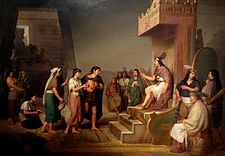Pulque
[5] The drink's history extends far back into the Mesoamerican period, when it was considered sacred, and its use was limited to certain classes of people.
It grows best in the cold, dry climates of the rocky central highlands to the north and east of Mexico City, especially in the states of Hidalgo and Tlaxcala.
However, plants destined for pulque production have this flower stalk cut off, leaving a depressed surface 12-18 inches in diameter.
[12] According to another story, pulque was discovered by the Tlacuache [t͡ɬaˈkʷat͡ʃe] (opossum), who used his human-like hands to dig into the maguey and extract the naturally fermenting juice.
[citation needed] Another account traces the discovery of aguamiel to the Toltec Empire, when a noble named Papantzin was trying to get the emperor to marry his daughter Xochitl.
Pulque appears in a number of graphic representations from pre-colonial times, beginning with stone carvings from about 200 CE.
The most likely means of the discovery of aguamiel and fermented pulque was from the observation of rodents who gnaw and scratch at the plant to drink the seeping sap.
It became a lucrative source of tax revenue, but by 1672, public drunkenness had become enough of a problem that the viceregal government created regulations to curtail its consumption.
A maximum of 36 "pulquerías" were permitted for Mexico City, which had to be located in open areas, be without doors and close at sundown.
However, pulque continued to play a major role in the socioeconomic history of Mexico during colonial times and in the early years of Independence.
[23] Other casta painters depicted Indigenous Americans intoxicated in the streets and incapacitated, which as a result required their families to escort them home.
[24] In one of his 1828 depictions, Italian lithographer Claudio Linati showed two Indigenous women engaged in a dispute outside of a pulquería.
[28] The complex and delicate fermentation process of pulque had always limited the product's distribution, as it does not keep long and agitation during transport speeds degradation.
[7] In the 1930s, the government of Lázaro Cárdenas campaigned against pulque, as part of an effort to reduce alcoholic consumption in general.
Some pulque producers have insisted that the muñeca is completely a myth, but modern historians suggest that it did happen, although only rarely.
[28][30] In part because of this strategy, pulque now generally looked down upon, and imbibed by relatively few people, with Mexican-brewed beer ubiquitous and extremely popular.
An estimated 10,000 plants are mutilated each week by cutting off the lower leaves for barbacoa or destroying them completely to look for the edible white grubs or ant eggs that can inhabit them.
Today, this liquid is collected with a steel scoop, but in the past, an elongated gourd was used as a tube to suck the juice out.
The upper parts of the walls opened for air circulation and the façades were sometimes decorated with indigenous designs or other images associated with the making of pulque.
[7][14] After placing the juice in the fermentation vats, mature seed pulque (semilla or xanaxtli) is added to "jump start" the process.
Unlike beer, the fermenting agent present in pulque is a bacterium of the species Zymomonas mobilis (syn.
But whether for rich or poor, two features stood out among these establishments: odd or catchy names, and murals decorating the walls.
Diego Rivera once said one of the most important manifestations of Mexican painting was the murals that decorated the facades and interiors of pulquerías.
The tradition at that time was to begin a pulque-drinking session by spilling a little on the floor or ground as an offering to Mother Earth.
Recently, pulque makers have found a way to preserve the beverage in cans, but they admit this does change the flavor.
The aspiration is that with this innovation, pulque can regain its lost market in Mexico and even achieve success as an export item, like tequila.
The original market was Mexican-American men, but the company reports the product is having success as a health food, sought out by athletes and body builders.
[38] There is a saying that pulque "sólo le falta un grado para ser carne" – "it is only a bit shy of being meat", referring to the purported nutritional value of the drink.
Modern analysis of the liquid has found that it contains carbohydrates; vitamins C, B-complex, D, and E; and amino acids and minerals such as iron and phosphorus.
However, most haciendas were the result of a constructive process that started in the 16th century, with mixed architectural styles and methods of both Mexico and Europe.














